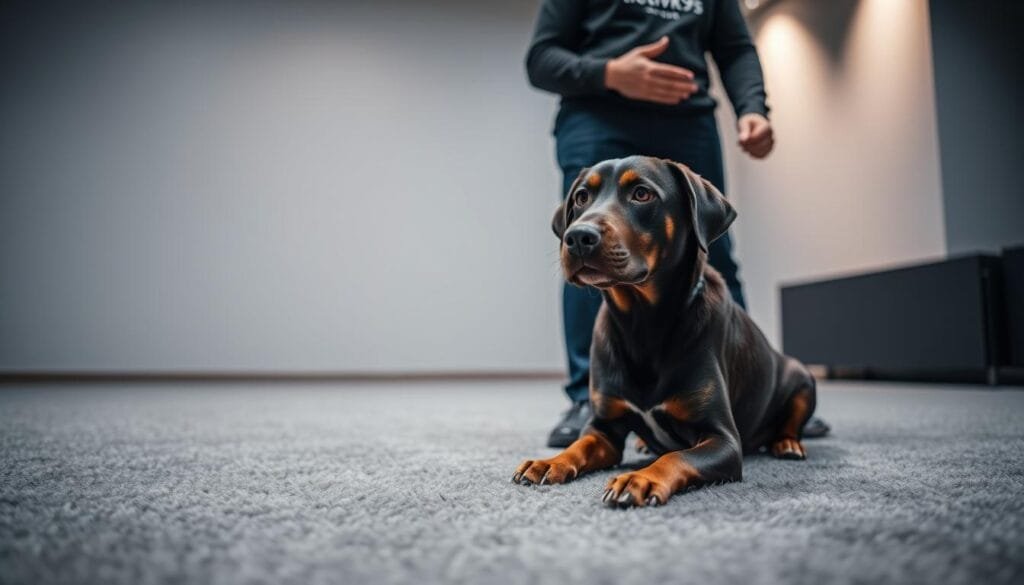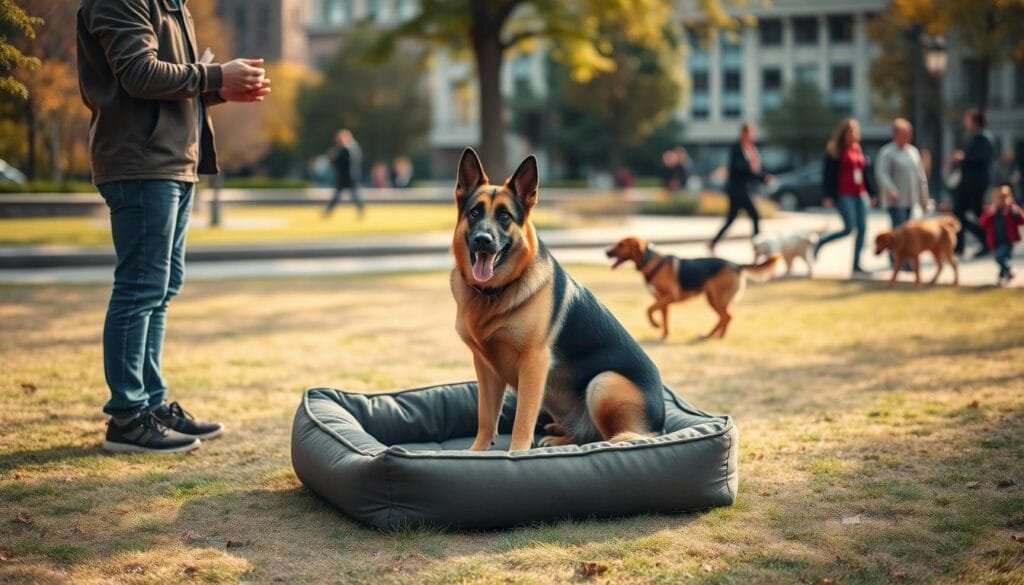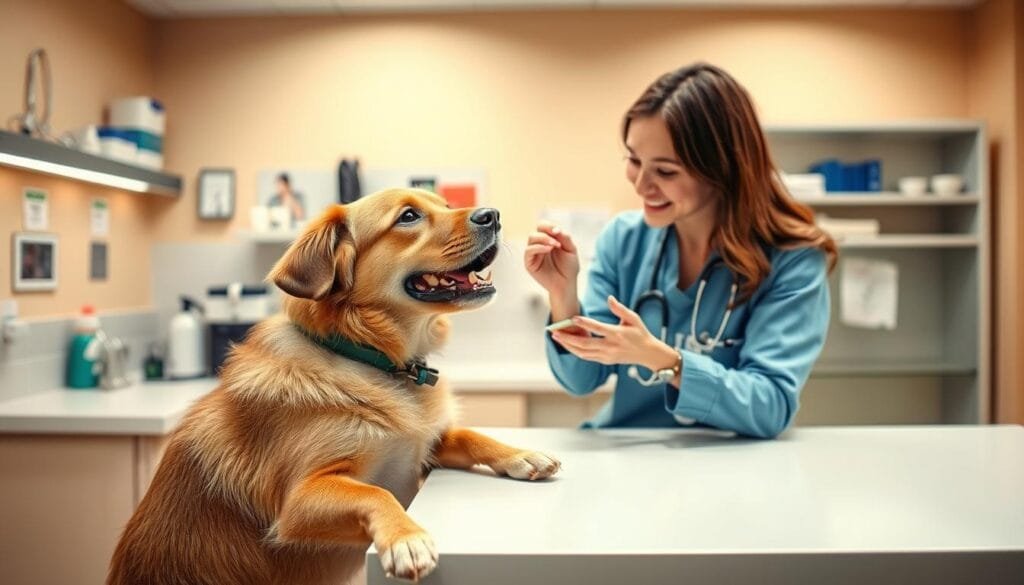Dog Behaviour Modification Training: Proven Methods
Did you know that 70% of dog owners face behavioural issues with their pets? This shows how vital effective dog behaviour modification training is. It helps create a better relationship between humans and dogs.
Dog training has changed a lot. It’s now based on science and kindness, not just punishment. Learning about dog behaviour modification starts with understanding that every dog is different. They need training that fits their own needs.
Today’s dog training is all about understanding dogs’ minds and how they communicate. It uses positive methods to help dogs behave better. With the right training, you can fix bad habits and make your bond with your dog stronger.
Key Takeaways
- Dog behaviour modification is essential for addressing pet behavioural challenges
- Positive reinforcement techniques are more effective than traditional punishment methods
- Understanding canine psychology is critical for successful training
- Individualised training plans yield the best results
- Consistent training can significantly improve dog behaviour
Understanding Modern Dog Training Approaches
Dog training has changed a lot in recent years. We now focus on how dogs learn and behave, moving away from old punishment methods. Instead, we use kinder, science-backed ways that care for dogs’ feelings.
Today’s dog training is all about understanding dogs’ minds and how they learn. Positive reinforcement is a key method. It rewards good behaviour instead of punishing bad ones.
The Science Behind Dog Training
Recent studies have shown us a lot about how dogs learn:
- Dogs learn through operant conditioning, where they get rewards for actions
- They are very good at solving problems, thanks to their brains
- Regular training helps them learn and remember good habits
Evolution of Training Methods
Training methods have changed a lot. Old ways that focused on dominance are now replaced by:
- Understanding and caring for a dog’s feelings
- Talking clearly to them
- Respecting each dog’s unique personality
Impact on Canine Psychology
Studies show that positive training helps dogs feel emotionally stable. Dogs that are trained with kindness and understanding have stronger bonds with their owners. They also feel more confident.
The best training sees dogs as living beings with their own feelings and ways of learning.
Positive Reinforcement Training Fundamentals
Positive reinforcement dog training is a strong way to shape your dog’s behaviour. It uses rewards to encourage good actions. This method gives your dog a reason to keep doing well.
The main idea is simple: give a reward right away when your dog does something good. This makes learning fun and effective.
- Rewards can include treats, toys, praise, and attention
- Timing is key – rewards must be given quickly after the behaviour
- Being consistent helps dogs understand what’s expected
Choose rewards that really excite your dog. Soft, small treats are great for quick training sessions. In different places, you might need more appealing rewards to keep your dog’s attention.
| Reward Type | Effectiveness | Best Used For |
|---|---|---|
| Food Treats | High | Initial Learning |
| Verbal Praise | Medium | Reinforcing Known Behaviours |
| Toys | Variable | High-Energy Dogs |
Studies prove positive reinforcement training works well. It cuts down on bad behaviour and boosts your dog’s confidence. By slowly giving fewer rewards but keeping the praise, your dog will learn reliable habits.
Dog Behaviour Modification Training: Essential Techniques
Dog behaviour modification training is a deep dive into understanding and changing how dogs act. Experts use special methods to help dogs behave better and get over tough habits.
Good dog behaviour training needs a careful and patient plan. Trainers look into why dogs act out and then use specific ways to fix it.
Clicker Training Methods
Clicker training for dogs is a precise way to teach them. It uses a small device that makes a clear sound. This sound tells the dog exactly when they do something right, making it easy for them to learn.
- Creates precise behavioural markers
- Builds strong communication signals
- Enables consistent training interactions
Reward-Based Behavioural Shaping
Reward-based shaping breaks down big behaviours into small steps. By rewarding small steps, trainers help dogs learn good habits.
| Training Stage | Objective | Reinforcement Strategy |
|---|---|---|
| Initial Assessment | Identify Current Behaviour | Baseline Observation |
| Incremental Training | Break Down Complex Behaviours | Targeted Reward System |
| Progressive Refinement | Strengthen Desired Responses | Consistent Positive Reinforcement |
Timing and Consistency in Training
Timing and consistency are key to dog training. Trainers must give rewards right after the dog does something good. This helps the dog learn fast and well.
- Instant feedback builds clear learning pathways
- Consistent approach prevents confusion
- Regular practice strengthens behavioural modifications
Using these key techniques, you can change your dog’s behaviour. It’s all about patient, scientific, and caring training.
Managing Aggressive and Fearful Behaviours
https://www.youtube.com/watch?v=bLeeeb3LVqY
Understanding aggressive dog behaviour is complex. It involves knowing the emotional world of dogs. Fear and anxiety in dogs show in different ways. Owners need to learn these signs and know how to handle them.
Dogs with fear-based aggression have clear warning signs. Studies show about 60% of aggressive behaviour comes from fear. Look out for these signs:
- Ears pinned back or turned sideways
- Excessive lip licking
- Persistent panting
- Trembling or body shaking
- Intense staring or avoiding eye contact
Dealing with aggressive dog behaviour needs care and strategy. Experts suggest positive reinforcement to improve emotional responses by up to 75%. Important steps include:
- Creating safe spaces for your dog
- Implementing controlled socialization
- Using counter-conditioning methods
- Avoiding punitive training techniques
Early intervention is key. The first 8-16 weeks are critical for socialization. This can lower fear aggression risk by 60%. Behaviour modification plans by experts can help in about 60% of cases.
Every dog is different. Be patient, understanding, and seek professional help. This is the best way to help your dog overcome fear and anxiety.
Desensitisation and Counter-Conditioning Protocols
Dog behaviour modification training is key to helping dogs with fear and anxiety. It’s about changing bad experiences into good ones. This helps your dog feel better emotionally.
Many dogs, up to 50%, react with fear to different things. So, desensitisation and counter-conditioning are vital for their emotional health.
Gradual Exposure Techniques
Gradual exposure is a main way to tackle fear and anxiety in dogs. It works like this:
- Start with the smallest amount of the scary thing
- Watch how your dog feels
- Slowly make the scary thing a bit stronger
Building Positive Associations
Counter-conditioning aims to change how your dog feels by linking scary things to good ones. It needs patience and regular practice.
| Training Aspect | Recommended Approach |
|---|---|
| Session Frequency | 2-3 times weekly |
| Session Duration | 5-45 minutes |
| Progression | Gradual intensity increase |
Progress Monitoring Methods
It’s important to watch your dog closely during training. Look for signs they’re getting better or feeling stressed, like:
- Less reacting
- Being calmer
- Being more okay with scary things
The British Small Animal Veterinary Association says long-term treatments like desensitisation help dogs with fears. Every dog is different, and getting help from a pro can make a big difference.
Advanced Impulse Control Training

Impulse control is key in dog training. It helps manage compulsive dog behaviours. About 70% of dog behaviour issues stem from poor impulse control. Learning these skills can greatly improve your dog’s behaviour.
Good impulse control training teaches dogs to think before acting. It’s about resisting immediate reactions and making better choices. The main strategies include:
- Teaching “Wait” and “Stay” commands
- Developing self-control during exciting situations
- Reducing reactive behaviours
- Enhancing overall obedience
Studies show dogs trained in impulse control see big improvements. Statistically, 50% of dogs reduce jumping and pawing behaviours within the first month of targeted training. Experts suggest using games and structured exercises to keep training fun and effective.
Impulse control is not about suppressing your dog’s personality, but about helping them make better choices.
Effective training techniques include:
- The “Leave It” command
- Door manners training
- Meal time patience exercises
- Distraction management
Training for 15-20 minutes, 3-5 times a week, can make a big difference. An impressive 80% of dog owners say their relationships with their dogs improved after consistent training.
Leash Training and Loose-Lead Walking Techniques
Learning to walk your dog on a leash is key to good dog training. Many owners face the problem of dogs pulling too much. This makes walks hard and stressful. But, with the right training, walks can become enjoyable and strengthen your bond with your dog.
Starting leash training means choosing the right gear. By law, dogs must wear a collar with ID. But, the right walking equipment can make a big difference in your training.
Proper Equipment Selection
- Choose a harness with front and back rings for better control
- Use three to four-foot training leads
- Avoid retractable leads and slip leads
- Select comfortable, well-fitted equipment
Progressive Training Steps
Teaching your dog to walk on a loose lead takes patience and consistency. Begin by creating a calm space before walking. Stop moving if the lead tightens. This teaches your dog that pulling doesn’t help them move forward.
Common Challenges and Solutions
Many owners find leash training tough. About 1 in 20 dogs need special training due to their energy levels. The solution is to keep training consistent across all family members.
A calm start to the walk is key to keeping control and improving your dog’s behavior.
With regular practice, you can change your dog’s walking habits. Over 88,000 dogs have learned to walk calmly. This shows that patience and the right training can beat any leash problem.
Professional Training Integration

Dealing with dog behaviour modification training is complex. It needs more than just basic home training. Professional dog obedience training offers a structured way to tackle your dog’s unique challenges.
Professional trainers have the skills to change your dog’s behaviour. They know the psychology behind dog learning. They can create plans for specific issues.
- Comprehensive assessment of your dog’s individual needs
- Customised training plans tailored to specific behavioural challenges
- Advanced techniques in dog behaviour modification training
- Expert guidance on resolving complex behavioural problems
When choosing a professional trainer, look at these important factors:
- Certification from recognised professional bodies
- Proven experience in dog obedience training
- Positive reinforcement methodologies
- Demonstrated success with similar behavioural issues
Professional training integration bridges the gap between home practice and expert intervention. Your dedication to training, combined with a trainer’s expertise, leads to lasting behavioural change.
Investing in professional dog behaviour modification training is an investment in your dog’s future wellbeing and your relationship.
Creating Long-Term Behaviour Modification Plans
Creating a detailed dog behaviour modification plan needs careful thought and patience. Success comes from making a plan that fits your dog’s specific issues and is realistic.
Important parts of a good long-term plan include:
- Setting clear, measurable goals
- Creating a structured training schedule
- Using consistent rewards
- Checking progress regularly
Studies show that a full assessment of your dog’s health and environment is key. Getting owners involved greatly boosts the chance of long-term success.
Dog behaviour training is a slow process. Your plan should be flexible, fitting your dog’s learning pace. It’s wise to work with certified experts for tailored advice and support.
Patience and consistency are your greatest allies in transforming challenging behaviours.
It’s vital to track how your dog is doing. Regular checks help see how well they’re improving, spot any problems, and make needed changes. A flexible yet structured plan leads to lasting positive changes in your dog’s behaviour.
Conclusion
Dog behaviour modification training is a key way to understand and improve your dog’s emotional and social growth. It uses science-based methods to tackle tough behaviours. This makes your relationship with your dog more harmonious.
Socialising your dog is vital to avoid future behavioural problems. Studies show up to 90% of dog owners face behavioural issues, with an average of 4.7 problems per dog. Professional training replaces bad behaviours with good ones, boosting your dog’s happiness and emotional balance.
Sticking to positive training methods can greatly lower the chance of behaviour getting worse. Using least invasive, minimally aversive (LIMA) methods helps your dog’s mental growth. This can stop many dogs from being given up to shelters, which happens often due to unaddressed behaviour issues.
Changing your dog’s behaviour is a long-term effort that needs patience, understanding, and learning. With the right approach, you can turn tough behaviours into positive ones. This strengthens your bond with your dog.
FAQ
What is dog behaviour modification training?
Dog behaviour modification training uses positive methods to change bad habits. It helps understand why dogs behave in certain ways. Then, it teaches them to react better to different situations.
How long does dog behaviour modification typically take?
The time it takes to change a dog’s behaviour varies. It depends on the problem, the dog’s personality, and how often you train. Some small issues might improve in weeks. But bigger problems could take months.
Is positive reinforcement effective for all types of dog behaviour problems?
Yes, positive reinforcement works well for most dog issues. This includes aggression, fear, anxiety, and compulsive behaviours. But, very serious problems might need more than just training.
What is clicker training, and how does it work?
Clicker training uses a device to make a sound when a dog does something right. This sound is followed by a treat. It helps dogs learn quickly which actions are good.
How can I address my dog’s aggressive behaviours safely?
To handle dog aggression safely, first find out what triggers it. Avoid punishing them. Use positive methods instead. Always talk to a professional dog behaviourist for serious cases.
Can older dogs learn new training techniques?
Yes, older dogs can learn new things. They might not pick up things as fast as puppies. But, with patience and the right training, they can learn.
What equipment do I need for behaviour modification training?
You’ll need treats, a clicker, a harness, a lead, and sometimes special tools. But the most important thing is your patience and commitment to positive training.
How do I know when to seek professional dog training help?
Get professional help if your dog has serious problems like aggression or anxiety. If your own training isn’t working, a pro can help. They can give you a plan to fix the issues.
What is desensitisation in dog training?
Desensitisation slowly introduces a dog to something they fear. It starts with a small amount and gets bigger, but always keeps the dog comfortable. It helps them not be scared of things they used to fear.
Can behaviour modification help with leash reactivity?
Yes, it can. Behaviour modification can teach dogs to stay calm on a leash. It uses positive methods and gradual exposure to hel



